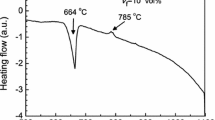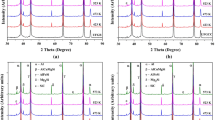Abstract
Both theoretical analysis and transmission electron microscopy (TEM) complementary studies have been conducted to evaluate the possible role of subgrain formation as a strengthening mechanism in a nanocomposite consisting of Al2O3 and 5 vol % 0.15 μm SiC particles. The theoretical calculation predicted that the residual stresses due to thermal expansion mismatch between Al2O3 and SiC are insufficient to induce the extensive plastic deformation required for subgrain formation upon annealing. This prediction was consistent with TEM observations that the bulk of the material was completely free from subgrains, and that only a low density of dislocations was present in isolated areas. The results suggest, therefore, that microstructure refinement through subgrain formation cannot account for the superior mechanical behaviour of the nanocomposite reported in previous studies.
TEM examination of the ground surfaces revealed significant plastic deformation in both single phase Al2O3 and the nanocomposite. Upon annealing at 1300°C for 2 h, dislocation-free subgrains were formed in Al2O3, whereas a high density of tangled dislocations were present in the nanocomposite. These observed differences are consistent with the fact that during annealing, residual stress relaxation is more difficult in the nanocomposite than in Al2O3.
Similar content being viewed by others
References
K. NIIHARA and A. NAKAHIRA, in Proceedings of the Third International Symposium on Ceramic Materials & Components for Engines (The American Ceramic Society, Westerville, OH, 1988) p. 919.
K. NIIHARA, A. NAKAHIRA, G. SASAKI and M. HIRABAYASHI, in Proceedings of the International Meeting on Advanced Materials, vol. 4 (The Materials Research Society, Japan, 1989) p. 124.
K. NIIHARA and A. NAKAHIRA, “Advanced structural inorganic composites”, edited by P. Vincenzini (Elsevier Science Publishers, Trieste 1990) p. 637.
J. ZHAO, L. C. STEARNS, M. P. HARMER, H. M. CHAN, G. A. MILLER and R. F. COOK,J. Amer. Ceram. Soc. 76 (1993) 503.
I. LEVIN, W. D. KAPLAN, DAVID G. BRANDON and A. A. LAYYOUS, to be published.
HANS WOHLFROMM,Ceram. Trans. 51 (1994) 659.
K. NIIHARA,J. Ceram. Soc. Japan 99 (1991) 974.
K. NIIHARA, A. NAKAHIRA and T. SEKINO,Mater. Res. Soc. Symp. Proc. 286 (1993) 405.
A. M. THOMPSON, H. M. CHAN and M. P. HARMER,J. Amer. Ceram. Soc. 78 (1994) 567.
J. FANG, H. M. CHAN and M. P. HARMER,Mater. Sci. Eng. A195 (1995) 163.
L. C. STEARNS, J. ZHAO and M. P. HARMER,J. Eur. Ceram. Soc. 10 (1992) 473.
J. SELSING,J. Amer. Ceram. Soc. 44 (1961) 419.
Y. S. TOULOUKIAN, R. K. KIRBY, R. E. TAYLOR and T. Y. R. LEE (eds) “Thermophysical properties of matter”, Vol. 13, (IFI/Plenum, New York, 1970).
R. MORRELL (ed) “Handbook of properties of technical & engineering ceramics”, Part 2 Data Reviews, Section 1 High-Alumina Ceramics, (Her Majesty’s Stationery Offce, London, 1987).
H. C. CHANDAN, Ph.D. Dissertation, Pennsylvania State University (1980).
Z. LI and R. C. BRADT,J. Amer. Ceram. Soc. 72 (1989) 70.
A. ABUHASAN, C. BALASINGH and P. PREDECKI,ibid. 73 (1990) 2474.
C. N. TOMÉ, M. A. BERTINETTI and S. R. MacEWEN,ibid. 73 (1990) 3428.
I. LEVIN, W. D. KAPLAN, D. G. BRANDON and A. A. LAYYOUS,ibid. 78 (1995) 254.
S. MAJUMDAR, D. KUPPERMAN and J. SINGH,ibid. 71 (1988) 858.
S. MAJUMDAR and D. KUPPERMAN,ibid. 72 (1989) 312.
R. M. CANNON, in “Structure and properties of MgO and Al2 O3 ceramics”, Advances in Ceramics Vol. 10, edited by W. D. Kingery (The American Ceramic Society, Inc., Westerville, OH, 1984) p. 818.
I. LEVIN, W. D. KAPLAN, D. G. BRANDON and T. WIEDER,Acta Metall. 42 (1994) 1147.
Y. WANG and D. E. MIKKOLA,J. Amer. Ceram. Soc. 75 (1992) 3252.
J. B. WACHTMAN, Jr. and L. H. MAXWELL,ibid. 37 (1954) 291.
Idem.,ibid. 40 (1957) 377.
M. L. KRONBERG,ibid. 45 (1962) 274.
Idem. Acta Metall. 5 (1957) 507.
M. RÜHLE, private communication (1995).
B. HOCKEY,J. Amer. Ceram. Soc. 54 (1971) 223.
E. J. WESTERMAN and F. V. LENEL,Trans. Met. Soc. AIME 218 (1960) 1010.
M. C. INMAN, K. M. ZWILSKY and D. H. BOONE,Trans. Amer. Soc. Metals 57 (1964) 701.
I. CHOU, H. M. CHAN and M. P. HARMER,J. Amer. Ceram Soc. 79 (1996) 2403.
Author information
Authors and Affiliations
Rights and permissions
About this article
Cite this article
FANG, J., HARMER, M.P. & CHAN, H.M. Evaluation of subgrain formation in Al2O3–SiC nanocomposites. Journal of Materials Science 32, 3427–3433 (1997). https://doi.org/10.1023/A:1018672717239
Issue Date:
DOI: https://doi.org/10.1023/A:1018672717239




